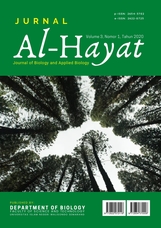Keanekaragaman Spesies Kupu-Kupu (Lepidoptera) pada Habitat Eko-wisata Taman Bunga Merangin Garden Bangko Jambi
Main Article Content
Abstract
Butterflies play an important role in the balance of ecosystems and function as a bioindicator for clean/healthy environment. Degradation and fragmentation of natural habitats threat the population of butterflies. Habitat conservation through eco-tourism is an way to keep the existance butterfly species. This study aims to identify the butterflies species, analyze species diversity, and abundance of butterflies (Lepidoptera) in the eco-tourism habitat of Merangin Garden Bangkang Jambi flower garden. Sampling was carried out five times at December 2018 to March 2019 using insect net. A total of 3 families from 16 species found. The species that dominated was Junonia orithya with 88 individuals (16.4%). The biodiversity value of butterflies species was 2.68. Diversity index is the lowest level of diversity. The types of flowers that bloom affect the high or low diversity index values. The most of butterflies found at 7.30 - 9.30 AM.
Downloads
Article Details
The copyright of the received article shall be assigned to the journal as the publisher of the journal. The intended copyright includes the right to publish the article in various forms (including reprints). The journal maintains the publishing rights to the published articles. Authors are allowed to use their articles for any legal purposes deemed necessary without written permission from the journal with an acknowledgment of initial publication to this journal.
The work under license Creative Commons Attribution-ShareAlike 4.0 International License.
References
Alfida., Hanum,U., & Eliyanti. (2016). Kupu-Kupu (Rhopalocera) di Kawasan Hutan Kota BNI Banda Aceh, Jurnal Biotik, Vol. 4, No. 2, Hal. 117-127.
Apituley, F.L., Leksono, A.S., dan Yanuwiadi, B. 2012. Kajian Komposisi Serangga Polinator Tanaman Apel (Malus Sylvestris Mill) di Desa Poncokusumo Kabupaten Malang. Kajian Komposisi Serangga. Vol. 2, No.2 Maret 2012. (85-96)
Borror, D.J., Triplehorn,C.A., & Jonhson, N.F. (Ed) (1992). Pengenalan pelajaran serangga. Yogyakarta: Gajah Mada University Press.
Brewer, R. (1994). The Science of Ecology. McGraw-Hill Company.
Fiedler, A.K., Landis, D.A., Wratten, S.D. 2008. Maximizing ecosystem services from conservation biological control: The role of habitat management. Biological Control 45 (2008) 254–271
Fox, R., Harrower, C. A., Bell, J. R., Shortall, C. R., Middlebrook,I., & Wilson, R. J. (2018). Insect population trends and the IUCN Red List process. Journal of Insect Conservation.https://doi.org/10.1007/s10841-018-0117-1.
Galetto, L., & Torres, C., (2002). Are Nectar Sugar Composition and Corolla Tube Length Related to the Diversity of Insects that Visit Asteraceae Flowers. Plant biology (Stuttg); 4(3): 360-366. DOI: 10.1055/s-2002-32326
Gandi, S., & Kumar, D., (2015). Studies on Butterfly diversity, abundance and utilization of plant resources in urban localities of Banyan city-Vadodara, Gujarat, India. Journal of Entomology and Zoology Studies. Vol 3(4): 476-480.
Garcia, M.T.A., & Gottsberger, G. (2009). Composition of the floral nectar of different subgenera of Argentinian passiflora species. Plant Syst Evol. Vol. 283:133–147.
Ghazanfar, M., Malik, M. F., Hussain, M., Iqbal, R., & Younas, M. (2016). Butterflies and their contribution in ecosystem: A review. Journal of Entomology and Zoology Studie. Vol. 4(2): 115-118.
Gullan, P.J., & Cranston, P.S.(2010). The insect: an Outline of Entomology. United Kingdom: Wiley-Blackwell.
Koneri, R & Maabuat, P.V. (2016). Diversity of Butterflies (Lepidoptera) in Manembo-Nembo Wildlife Reserve, North Sulawesi, Indonesia. Pakistan Journal of Biological Sciences. Vol. 19 (5):202-210.
Leo, S., Avifah, N., Sasangka, A.N., & Zahra, S. (2016). Butterflies of Baluran National Park, East Java, Indonesia. Pros Sem Nas Masy Biodiv Indon. Volume 2, Nomor 2
Marazzi, B., Bronstein, J.L., & Koptur, S. (2013). The diversity, ecology and evolution of extrafloral nectaries: current perspectives and future challenges. Annals of Botany. Vol.111: 1243–1250.
Odum, E. (1993). Dasar-dasar Ekologi. Yogyakarta: Gadjah Mada University press.
Peggie, D. & Amir, M. (2006). Panduan Praktis Kupu-kupu di Kebun Raya Bogor. Puslitbang Biologi. Bogor: LIPI Press.
Schlindwein, C., Westerkamp, C., Carvalho, A.T., & Milet-Pinheiro,P. (2014). Visual signalling of nectar-offering flowers and specific morphological traits favour robust bee pollinators in the mass-flowering tree Handroanthus impetiginosus (Bignoniaceae). Botanical Journal of the Linnean Society. 176, 396–407.
Sedgley, M dan Griffin, A.R. 1989. Sexual Reproduction of Tree Crops. Forest Ecology and Management. Volume 35,
Tiple, A.D. (2012). Butterfly species diversity, relative abundance and status in Tropical Forest Research Institute, Jabalpur, Madhya Pradesh, central India. Journal of Threatened Taxa. Vol. 4(7): 2713–2717.
Yanuar, A., Mun’im, A., Lagho, A.B.A., Syahdi, R.R., Rahmat, M., & Suhartanto, H. (2011). Medicinal Plants Database and Three Dimensional Structure of the Chemical Compounds from Medicinal Plants in Indonesia. International Journal of Computer Science Issues, Vol. 8,
Zhongmin, W., dan Yunfei, Y. 2012. Species diversity of butterflies in Changbai Mountain in China. Acta Ecologica Sinica 32 (2012) 279–284

